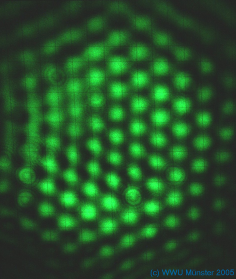Self-organization and pattern formation

Laser beam displaying a transverse hexagonal structure originating from self-organization.
Self-organization is a collective phenomenon observable in co-operating nonlinear systems. Co-operation conveys new macroscopic properties of an encompassing system that can neither be directly inferred nor understood by solely considering its component systems. Such emergent properties usually introduce a new degree of order to the systems. As a result of self-organization, entropy can be seen to decrease. As this is only possible in open systems, absence of themodynamic equilibrium is a precondition for the existence of self-organization.
Spatial pattern formation is an aspect of self-organization where a spatially homogeneous state of a system yields to a spatially structured state. Appearance of spatial correlation on certain scales requires a spatial coupling. In addition, dissipative processes are necessary for the existence of stationary patterned states in a nonlinear nonequilibrium systems.
Phenomena involving the self-organized formation of spatial patterns can often be considered independent of the actual microscopic system. Instead, strikingly similar processes are observed in quite different areas of physics, chemistry and biology. Therefore, experimentally convenient systems can be employed for investigations addressing general propertuies of pattern formation. Knowledge obtained from one system can be generalized, possibly resulting in predictions valid for other systems. We investigate the generation of spatial patterns in two exemplary systems. Both systems feature a single-feedback geometry. In one case, an optically addressable nonlinearity (a liquid crystal light valve, LCLV) is employed, in the other coherent two-wave mixing in a photorefractive crystal provides the nonlinearity.

